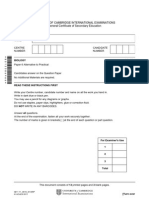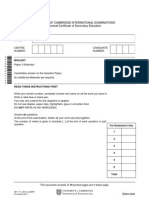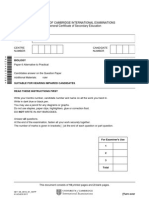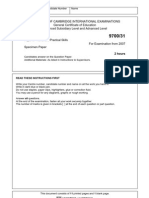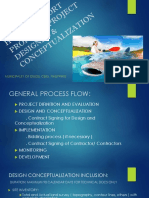0610 s07 QP 6
0610 s07 QP 6
Uploaded by
Kassem FarhatCopyright:
Available Formats
0610 s07 QP 6
0610 s07 QP 6
Uploaded by
Kassem FarhatOriginal Title
Copyright
Available Formats
Share this document
Did you find this document useful?
Is this content inappropriate?
Copyright:
Available Formats
0610 s07 QP 6
0610 s07 QP 6
Uploaded by
Kassem FarhatCopyright:
Available Formats
w w w e tr .
X m ap eP
UNIVERSITY OF CAMBRIDGE INTERNATIONAL EXAMINATIONS International General Certificate of Secondary Education
s er om .c
*5235632697*
BIOLOGY Paper 6 Alternative to Practical
0610/06
May/June 2007 1 hour
Candidates answer on the Question Paper. No Additional Materials are required. READ THESE INSTRUCTIONS FIRST Write your Centre number, candidate number and name on all the work you hand in. Write in dark blue or black pen. You may use a pencil for any diagrams or graphs. Do not use staples, paper clips, highlighters, glue or correction fluid. DO NOT WRITE IN ANY BARCODES. Answer all questions. At the end of the examination, fasten all your work securely together. The number of marks is given in brackets [ ] at the end of each question or part question.
For Examiner's Use 1 2 3 4 Total
This document consists of 10 printed pages and 2 blank pages.
IB07 06_0610_06/4RP UCLES 2007
[Turn over
2 1 An investigation was carried out to show the effects of temperature on plant growth. Two sets of soaked bean seeds were placed on moist paper in containers. The containers were wrapped in foil to keep out the light. One container was placed for three days in a refrigerator at 4 C. The other container was left for three days in a warm place at 30 C.
For Examiner's Use
Fig. 1.1 and Fig. 1.2 show these two sets of germinated bean seedlings after three days.
seedlings grown in refrigerator at 4 C
3 Fig. 1.1
seedlings grown in a warm place at 30 C
3 Fig. 1.2
UCLES 2007
0610/06/M/J/07
3 (a) (i) Measure the overall length of the seedlings to the nearest mm and record these measurements in Table 1.1. Table 1.1 length of seedling / mm seedling 1 2 3 4 5 mean [3] (ii) Calculate the mean length of the seedlings in Fig 1.1 and the mean length of the seedlings in Fig. 1.2 and also record these values in Table 1.1. grown in refrigerator at 4 C grown in a warm place at 30 C
For Examiner's Use
[2]
UCLES 2007
0610/06/M/J/07
[Turn over
4 (b) (i) Describe and explain the differences in appearance of the set of seedlings grown at 4 C and those grown at 30 C.
For Examiner's Use
[6] (ii) Explain why it is necessary to measure the length of more than one seedling and calculate the mean.
[1] [Total: 12]
UCLES 2007
0610/06/M/J/07
5 BLANK PAGE
0610/06/M/J/07
[Turn over
6 2 Fig. 2.1 shows a stage in the life cycle of an animal.
For Examiner's Use
Fig 2.1 (a) Make a large, labelled drawing of the stage shown in Fig. 2.1.
[4]
UCLES 2007
0610/06/M/J/07
7 (b) Fig. 2.2 shows an adult of a similar species.
For Examiner's Use
Fig. 2.2
(i) Name the group of organisms to which this animal belongs. [1] (ii) List three features of the adult stage visible in Fig. 2.2 which helped you to classify this animal. 1 2 3 [3]
UCLES 2007
0610/06/M/J/07
[Turn over
8 (c) Temperature will affect the length of the life cycle of this animal. Figs. 2.3 and 2.4 show two stages in its life cycle.
For Examiner's Use
Fig. 2.3
Fig. 2.4
The data in Table 2.1 shows the days for the development between the stages shown in Figs. 2.2, 2.3 and 2.4. Table 2.1 Time taken for development between life cycle stages / days temperature / C 10 16 21 25 32 from stage shown in Fig. 2.3 to that in Fig. 2.4 43 27 16 10 5 from stage shown in Fig. 2.4 to adult shown in Fig. 2.2 23 16 12 7 4
UCLES 2007
0610/06/M/J/07
9 (i) Using this data, plot a suitable graph to show the effect of temperature on the time taken for development of the stage shown in Fig. 2.4 to the adult stage shown in Fig. 2.2.
For Examiner's Use
[5] (ii) Describe and explain the effect of temperature on the development of this animal.
[3] [Total:16]
UCLES 2007
0610/06/M/J/07
[Turn over
10 3 Fig. 3.1 shows part of a root tip cut longitudinally. The section has been stained to show the DNA of the nucleus.
For Examiner's Use
Fig. 3.1 (a) (i) Draw a circle around a cell that shows the daughter chromosomes have just separated at the equator and are moving towards the poles of the cell (anaphase). [1] (ii) Describe two visible features of these dividing cells. 1 2 (iii) Name the type of cell division taking place. [1] (b) Suggest what happens to these cells after cell division, as the root grows. [2]
[2] [Total: 6]
UCLES 2007
0610/06/M/J/07
11 4 A nutritional drink was said to contain simple sugars and protein. Describe how you could find out if these food substances were present in the drink.
For Examiner's Use
[6] [Total: 6]
UCLES 2007
0610/06/M/J/07
12 BLANK PAGE
Permission to reproduce items where third-party owned material protected by copyright is included has been sought and cleared where possible. Every reasonable effort has been made by the publisher (UCLES) to trace copyright holders, but if any items requiring clearance have unwittingly been included, the publisher will be pleased to make amends at the earliest possible opportunity. University of Cambridge International Examinations is part of the Cambridge Assessment Group. Cambridge Assessment is the brand name of University of Cambridge Local Examinations Syndicate (UCLES), which is itself a department of the University of Cambridge.
0610/06/M/J/07
You might also like
- DPR On Wooden Furniture Manufacturing UnitDocument5 pagesDPR On Wooden Furniture Manufacturing Unitarka gifts100% (1)
- Cabre, Theories of TerminologyDocument37 pagesCabre, Theories of Terminologytranslatum100% (3)
- History of Compton CountyDocument302 pagesHistory of Compton CountyNancy100% (3)
- 0610 s07 QP 5 PDFDocument8 pages0610 s07 QP 5 PDFBakir JaberNo ratings yet
- 0610 w11 QP 61Document16 pages0610 w11 QP 61Seif HatemNo ratings yet
- BIOLOGY Paper 6 Alternative To PracticalDocument12 pagesBIOLOGY Paper 6 Alternative To PracticalTheencyclopediaNo ratings yet
- 0610 w11 QP 63Document12 pages0610 w11 QP 63Samiya MallickNo ratings yet
- 0610 w06 QP 3Document16 pages0610 w06 QP 3farsxdchgNo ratings yet
- 0610 w11 QP 52Document8 pages0610 w11 QP 52Seif HatemNo ratings yet
- University of Cambridge International Examinations International General Certificate of Secondary EducationDocument12 pagesUniversity of Cambridge International Examinations International General Certificate of Secondary EducationRahique ShuaibNo ratings yet
- 0610 w11 QP 32Document20 pages0610 w11 QP 32Seif HatemNo ratings yet
- IGCSE 2012 - Paper 2 November PDFDocument20 pagesIGCSE 2012 - Paper 2 November PDFjanovaNo ratings yet
- 0610 s11 QP 31Document20 pages0610 s11 QP 31karan79No ratings yet
- 0610 w07 QP 3 PDFDocument33 pages0610 w07 QP 3 PDFHaider AliNo ratings yet
- 0610 s10 QP 21 PDFDocument16 pages0610 s10 QP 21 PDFHaider AliNo ratings yet
- 9700 s11 QP 34Document12 pages9700 s11 QP 34Ahmed Kaleem Khan NiaziNo ratings yet
- 0610 w09 QP 31Document20 pages0610 w09 QP 31mureeeenNo ratings yet
- 0610 s13 QP 61 PDFDocument12 pages0610 s13 QP 61 PDFHaider AliNo ratings yet
- 0610 w11 QP 22Document20 pages0610 w11 QP 22If HassanNo ratings yet
- STD X - Biology - Paper VI FinalDocument8 pagesSTD X - Biology - Paper VI FinalYashodhaNo ratings yet
- 0610 s13 QP 62 PDFDocument16 pages0610 s13 QP 62 PDFHaider AliNo ratings yet
- 0610 s11 QP 61Document12 pages0610 s11 QP 61Omar HusseinNo ratings yet
- 0610 s13 QP 61in ProgressDocument12 pages0610 s13 QP 61in ProgressEzhilarasiPazhanivelNo ratings yet
- 0610 s14 QP 21Document20 pages0610 s14 QP 21Chui WaiNo ratings yet
- 0610 w12 QP 61Document16 pages0610 w12 QP 61Choudhry WalidNo ratings yet
- 0610 s13 QP 63 PDFDocument16 pages0610 s13 QP 63 PDFHaider AliNo ratings yet
- November 2012 Question Paper 32 PDFDocument20 pagesNovember 2012 Question Paper 32 PDFSamson YauNo ratings yet
- Location Entry CodesDocument33 pagesLocation Entry CodesFatima BilalNo ratings yet
- 0610 w12 QP 63Document12 pages0610 w12 QP 63ArasiveluNo ratings yet
- 0610 s12 QP 33Document24 pages0610 s12 QP 33karan79No ratings yet
- 0610 w10 QP 63Document12 pages0610 w10 QP 63lifeinacsNo ratings yet
- QP 6 FellDocument464 pagesQP 6 FellAliMushtaq0% (1)
- 5090 w14 QP 62Document8 pages5090 w14 QP 62Rahique ShuaibNo ratings yet
- 0610 w11 QP 21Document24 pages0610 w11 QP 21Muhammad Azhar HayatNo ratings yet
- 9700 Y07 SP 31Document16 pages9700 Y07 SP 31Deepti NageshNo ratings yet
- Cambridge IGCSE: BIOLOGY 0610/62Document12 pagesCambridge IGCSE: BIOLOGY 0610/62tentaclesspex31No ratings yet
- University of Cambridge International Examinations General Certificate of Education Ordinary LevelDocument8 pagesUniversity of Cambridge International Examinations General Certificate of Education Ordinary Levelmstudy123456No ratings yet
- 0610 s06 QP 2Document16 pages0610 s06 QP 2Daishaadil DilNo ratings yet
- 2024 08 06 Limpopo LFSC Prac Test 2 Gr11 QP ENGDocument8 pages2024 08 06 Limpopo LFSC Prac Test 2 Gr11 QP ENGpontshoraboshakga3No ratings yet
- 0610 w10 QP 63Document12 pages0610 w10 QP 63Awni AburamadanNo ratings yet
- University of Cambridge International Examinations International General Certificate of Secondary Education BiologyDocument16 pagesUniversity of Cambridge International Examinations International General Certificate of Secondary Education BiologyHaider AliNo ratings yet
- CAIE GrPreIG Biology P4 QP AY21-22Document17 pagesCAIE GrPreIG Biology P4 QP AY21-22khyavichhedaNo ratings yet
- CAIE GrPreIG Biology P6 QP&MS AY21-22Document12 pagesCAIE GrPreIG Biology P6 QP&MS AY21-22khyavichhedaNo ratings yet
- 0610 s13 QP 31Document20 pages0610 s13 QP 31Choudhry WalidNo ratings yet
- Cambridge IGCSE: BIOLOGY 0610/43Document20 pagesCambridge IGCSE: BIOLOGY 0610/43Tamer AhmedNo ratings yet
- 0610 s12 QP 31Document20 pages0610 s12 QP 31Choudhry WalidNo ratings yet
- Biology Revision BookletDocument59 pagesBiology Revision BookletSiddhant ShahNo ratings yet
- Life Sciences GR 12 Worksheet 3Document5 pagesLife Sciences GR 12 Worksheet 3civilndlovu13No ratings yet
- 9700 s13 QP 33Document12 pages9700 s13 QP 33soul199570No ratings yet
- Higher Tier Biology 1: P.M. Wednesday, 30 May 2012 45 MinutesDocument14 pagesHigher Tier Biology 1: P.M. Wednesday, 30 May 2012 45 MinutessureshthevanNo ratings yet
- University of Cambridge International Examinations International General Certificate of Secondary EducationDocument20 pagesUniversity of Cambridge International Examinations International General Certificate of Secondary EducationBebeNo ratings yet
- Biology Paper 2Document13 pagesBiology Paper 2Aniel DanielNo ratings yet
- 0610 s10 QP 61Document12 pages0610 s10 QP 61Windy WayneNo ratings yet
- Test 1: For Examiner Use OnlyDocument6 pagesTest 1: For Examiner Use OnlyHafiy HakimiNo ratings yet
- The Fundamentals of Scientific Research: An Introductory Laboratory ManualFrom EverandThe Fundamentals of Scientific Research: An Introductory Laboratory ManualNo ratings yet
- Bioprocessing for Cell-Based TherapiesFrom EverandBioprocessing for Cell-Based TherapiesChe J. ConnonNo ratings yet
- Adhesion in Foods: Fundamental Principles and ApplicationsFrom EverandAdhesion in Foods: Fundamental Principles and ApplicationsNo ratings yet
- Hybridization, Diagnostic and Prognostic of PEM Fuel Cells: Durability and ReliabilityFrom EverandHybridization, Diagnostic and Prognostic of PEM Fuel Cells: Durability and ReliabilityNo ratings yet
- Undergraduate Application 2014-2015Document3 pagesUndergraduate Application 2014-2015Kassem FarhatNo ratings yet
- English Language Qualifications-Griffith UniversityDocument4 pagesEnglish Language Qualifications-Griffith UniversityKassem FarhatNo ratings yet
- 0610 w03 Ms 1+2+3+5+6Document22 pages0610 w03 Ms 1+2+3+5+6Kassem Farhat0% (1)
- 0610 s09 QP 6Document12 pages0610 s09 QP 6Kassem Farhat0% (1)
- O Level Bs NotesDocument19 pagesO Level Bs NotesKush GurbaniNo ratings yet
- 0417 w10 Ms 3Document11 pages0417 w10 Ms 3Kassem FarhatNo ratings yet
- University of Cambridge International Examinations International General Certificate of Secondary Education BiologyDocument12 pagesUniversity of Cambridge International Examinations International General Certificate of Secondary Education BiologyVarun PanickerNo ratings yet
- 0610 s03 Ms 1+2+3+5+6Document32 pages0610 s03 Ms 1+2+3+5+6Zeid NawasNo ratings yet
- 0417 s10 Ms 11Document7 pages0417 s10 Ms 11Kassem FarhatNo ratings yet
- Igcse Sociology Past ModuleDocument16 pagesIgcse Sociology Past ModuleKassem FarhatNo ratings yet
- English 2Document4 pagesEnglish 2Rajarshi MahatoNo ratings yet
- Minutes-of-Meeting-FGD On CID Technical Assistance in MathDocument4 pagesMinutes-of-Meeting-FGD On CID Technical Assistance in MathLudivina Bernardo100% (2)
- Chapter 4 2020Document17 pagesChapter 4 2020JAEHYUK YOONNo ratings yet
- Drink RecipiesDocument12 pagesDrink Recipiestaxsam14No ratings yet
- Tranformer, Panels & Cable - GTP and DrawingsDocument86 pagesTranformer, Panels & Cable - GTP and DrawingsDarshit VyasNo ratings yet
- Personal Balanced Scorecard TemplatesDocument4 pagesPersonal Balanced Scorecard Templatesj.faraone21No ratings yet
- Al2O3 Trong PinDocument10 pagesAl2O3 Trong PinHà An Đỗ NgọcNo ratings yet
- HSE PRESENTATION On ErgonomicsDocument98 pagesHSE PRESENTATION On ErgonomicsOnyema Emmanuel100% (1)
- Abstract Booklet - Asian Powers in The Eastern MedDocument38 pagesAbstract Booklet - Asian Powers in The Eastern MedAnonymous 7PNVhPuNo ratings yet
- Chapter 8 Performance ManagementDocument64 pagesChapter 8 Performance Managementkosasih wendelinNo ratings yet
- Hotel + Resort Proposed Project Designed & ConceptualizationDocument27 pagesHotel + Resort Proposed Project Designed & ConceptualizationianNo ratings yet
- Isd Cy Team Contact Lists - Saint John To SussexDocument3 pagesIsd Cy Team Contact Lists - Saint John To Sussexapi-313161746No ratings yet
- 9 Balint PDFDocument6 pages9 Balint PDFdiego silva ramosNo ratings yet
- ESW Capital OverviewDocument7 pagesESW Capital OverviewHaseeb Ahmed KhanNo ratings yet
- Case Study Business Process Re-Engineering of Supply Chain Activities in Attock Petroleum Limited (APL)Document9 pagesCase Study Business Process Re-Engineering of Supply Chain Activities in Attock Petroleum Limited (APL)Ash LayNo ratings yet
- Lesson 4: Mean and Variance of A Discrete Random VariablesDocument11 pagesLesson 4: Mean and Variance of A Discrete Random VariablesIsabella MondragonNo ratings yet
- Tab Notation LegendDocument2 pagesTab Notation LegendCamarHall100% (1)
- Broadsheets vs. Tabloids: Neutrality vs. SensationalismDocument22 pagesBroadsheets vs. Tabloids: Neutrality vs. Sensationalismduneden_1985100% (5)
- Chapter 2 - (Lesson 4 & 5 - Activity)Document5 pagesChapter 2 - (Lesson 4 & 5 - Activity)Plain KitchenNo ratings yet
- OSCPDocument86 pagesOSCPabhilashchris63No ratings yet
- QUASI - Judicial PowerDocument100 pagesQUASI - Judicial PowerPauline Eunice Lobigan100% (1)
- Camiguin Polytechnic State College Rotc UnitDocument33 pagesCamiguin Polytechnic State College Rotc UnitgomonyNo ratings yet
- Allotment of Director Identification Number (Din) PDFDocument1 pageAllotment of Director Identification Number (Din) PDFAJAY SINGHNo ratings yet
- Keeping Pets (Student's Copy)Document11 pagesKeeping Pets (Student's Copy)Han HuiminNo ratings yet
- A13 Bionic ChipDocument12 pagesA13 Bionic ChipManikanta SriramNo ratings yet
- Mitsubishi AA121XN11 SpecificationDocument3 pagesMitsubishi AA121XN11 SpecificationteltronNo ratings yet
- IOSH MS Project.3.1Document13 pagesIOSH MS Project.3.1ghada gattouchNo ratings yet




